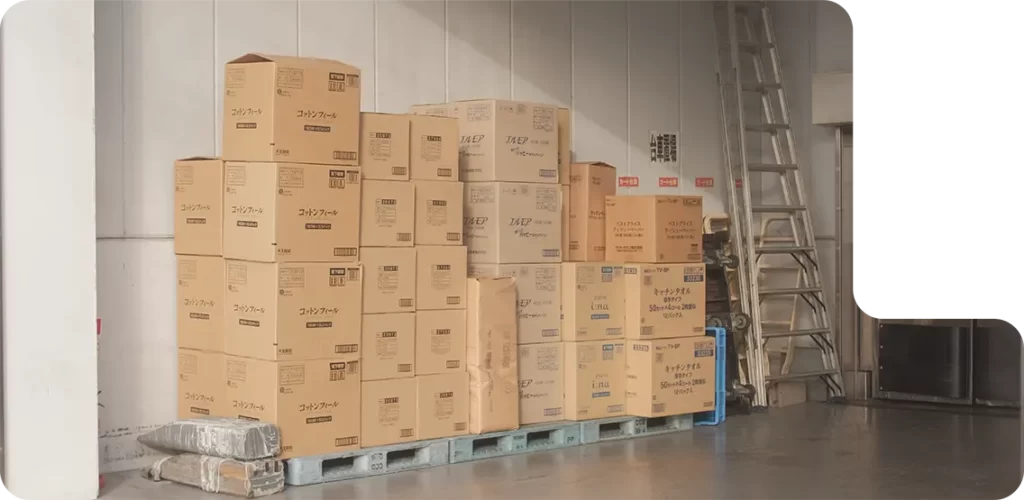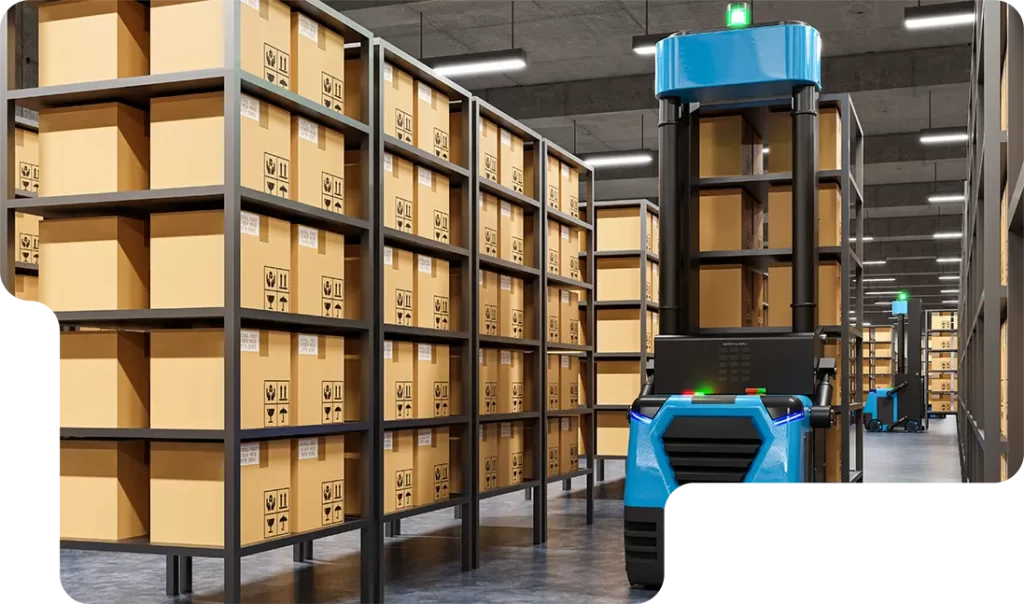Table of Contents
More Inventory Content
Subscribe to get the latest news!
Table of Contents
More Inventory Content
Share this
Subscribe to get the latest news!
Table of Contents
Share This
More Fulfillment Content
Subscribe to get the latest news!
Efficient inventory management entails knowing exactly how much to order to fulfill demands without having anything in excess. It requires business experience, predictive data analytics, and target market insights. However, even the most cautious and foresighted inventory managers can miscalculate and overorder, leading to excess inventory known as dead stock.
Dead stock is an issue that many inventory managers and warehouse operators face. Not only does it take up valuable warehouse space, but it also affects a business’s cash flow and revenue.

What Is Dead Stock?
Dead stock refers to the excess inventory that is not marketable and lying in the warehouse for a prolonged period. Also known as obsolete or dead inventory, goods in the dead stock are not likely to be sold in the near future.
Unlike safety stock, goods in dead stock were not ordered with the intention of stocking up to account for contingencies. The excess, unsellable inventory loses value over time, eventually expiring or deteriorating. Hence, the dead stock burdens warehouse resources and significantly impacts a company’s bottom line.
Alternatively, dead stock can also refer to the products that are no longer available for sale. In that case, we use the term “dead stock” to refer to such items.
Examples of dead stock can include coveted merchandise no longer available in stores but still having authentic tags. For instance, vintage apparel and fabric or discontinued lines of sneakers sold for their brand imaging are popular dead stock categories. As opposed to dead stock, dead stock items typically sell at a premium price.

Example of Dead Stock
A retailer or e-commerce merchant may find themselves with dead stock because they ordered or produced too many items that did not sell as expected. Dead stock may also include leftover seasonal products, damaged goods, expired raw materials, or incorrect delivery items.
However, dead stock does not include goods returned by customers. Perishable items like food products and medicines that must be discarded after a specific period can quickly become dead stock inventory if not sold as anticipated.
Here’s an example of dead stock to clear things up. Say you are an online grocer and ordered 200 sacks of refined flour. Per your inventory forecasting, you expect to sell all units within two months.
However, a new health trend takes over the market, and the demand for refined flour drops sharply. Now, consumers are more drawn toward healthier alternatives such as whole wheat flour and almond flour. As a result, you can only sell about 50 units in those two months with no possibility of selling the remaining 150 units any time soon.
The remaining units of refined flour are now dead stock. These items will take up warehouse space, drain your warehouse resources, and will possibly go bad before you can get rid of them.
Stocks do not become dead overnight; it is often a lengthy process and begins when inventory remains unsold and sits in the warehouse for a prolonged period. When it comes to accounting, inventory that does not turn over for a year becomes a liability and is deemed dead stock.

What Causes Dead Stock?
Having unsold products lying around in the warehouse is pretty common, and almost any business can end up with unwanted goods that are a liability. It is not always feasible to accurately predict demands, and fluctuating economic factors often impact consumer spending.
Here are a few reasons why businesses may face dead stock:
Erroneous Forecasting
Inventory forecasting cannot always be 100% accurate. Even if you have all the data and tools at your disposal, flawed data, new market competitors, shifting market trends, and factors beyond the company’s control may prompt businesses to make incorrect forecasts and order excess inventory. High inventory volumes will likely become dead stock if demands don’t turn out as expected.
Ordering Inconsistencies
Inconsistency in ordering practices means that a business either orders items at the wrong time or purchases too many things at once. Either way, the result is excess inventory that leads to dead stock. Ordering inconsistency can result from not tracking crucial inventory management KPIs such as inventory turnover ratio and reorder point formula.
Damaged Products
Quality issues resulting from subpar or defective items can leave you with products that customers refuse to buy. Defective products primarily result from a lack of appropriate quality checks and non-compliance with packaging requirements or product specifications. Stocks not selling because of poor quality can result in excess inventory.
Inadequate Demand Or Poor Sales
There can be several reasons your products have insufficient demand and inventory does not sell. The product may be available elsewhere at a lower price, the product is outdated or seasonal, or because its market competitor or alternative is more appealing. As a result, such products end up as dead stock and a liability to the business.
Market Cannibalization
If you offer a variety of products, those with similar features and target markets as products from other brands can face cannibalization. While you may not lose all your customers, a significant portion of your current customer base may shift to more popular selling items. Thus, market cannibalization can reduce sales and leave you with dead stock.
Lack Of An Inventory Management System
If a business is still using spreadsheets to monitor and track inventory manually, the chances are that they will face dead stock. Traditional inventory management techniques are error-prone, and losing track of incoming inventory or products you already have is easy. Thus, you will likely end up placing orders for products you do not need.

Why Is Dead Stock Bad For Business?
Dead stock is not a pleasant situation for any business. It burdens warehouse space and resources, increases carrying costs, impacts revenue, and ties up capital.
Here is a list of the reasons elaborating why dead stock is detrimental to businesses:
Takes Up Valuable Warehouse Space
Dead stock comprises high inventory volumes that occupy shelves and valuable warehouse space. The dead stock takes up space that could otherwise be used for fast-moving inventory or goods that sell faster.
Increased Carrying Costs
Inventory carrying or holding cost is the expense associated with storing inventory and typically includes labor, storage space, and insurance. Dead stock ties up capital and increases the carrying cost, leaving lesser money for the company to invest in other ventures.
Sells At A Loss
Even if a business manages to sell the dead stock, it does so at a loss. Moreover, spending more time on unmarketable products concurrently increases space and labor costs. Thus, with dead stock, a business has no scope to generate profit or break even.
Results In Lost Money
Selling products is the only way businesses can recoup their investments in inventory. However, companies lose the opportunity to recoup their invested capital because the excess, unsellable inventory results in lost money.
Increased Staffing Costs
The more stock accumulates on warehouse shelves, the more staff and resources are required to manage the inventory. Since dead stock only takes up warehouse space and has no real value, it eventually leads to higher staffing costs.

Cost of Dead Stock
Items in dead stock start as assets but eventually become a liability involving expenses that a business cannot recover. It is a problem for both brick-and-mortar stores and e-commerce merchants because dead stock is overall a bad investment for the company.
Here are the main costs involved in having dead stock lying around in your warehouse:
- Cost of the products: It is the amount of money a business invests in producing or purchasing the products (that become dead stock).
- Storage costs: The cost of storage includes warehouse space, utilities, equipment, insurance, warehouse overhead, and other resources.
- Maintenance costs: There are costs involved in maintaining the excess inventory, such as employing more workers. More staff means more money for wages that eventually impacts the company’s bottom line.
- Cost of missed opportunities: Since there is no chance of dead stock products making it to customers, a business has no scope to break even, let alone generate profits. Dead stock ties up cash that could have been invested in profitable items.

How To Avoid Dead Stock?
Here are some best practices you can adopt to prevent inventory from piling up and becoming a liability to your business:
Use Inventory Management Software
Lack of inventory management is the primary reason behind dead stocks. Trying to keep tabs on your inventory through manual effort means losing track of your products, what you have placed orders for, and what is moving. An inventory management software can automate your retail business or warehouse’s purchase orders and inventory workflow. With a real-time and intuitive system, you can accurately track your inventory while identifying fast and slow-moving stock and deciding the best reorder points and quantity.
Stay Updated With Market Trends And Forecasts
Do some market research and keep an eye out for trends and forecasts to help you decide on the products you should stock. Survey your current customer base and gather insights on what is trending among your buyer persona. With these insights, you can predict what products may perform well and stock up on those least likely to turn into dead stock. Leverage inventory software to come up with the best estimates for your business based on analytics reports and automated tracking.
Sell Potential Dead Stock Items At Discounts
Instead of waiting for inventory to become dead stock, proactively put them up for sale at discounted prices. Market trend data is enough to estimate what is selling now, what is likely to sell in the future, what will continue to be popular in the long run, and what will lose popularity eventually. For instance, holiday products typically vanish from the shelves in the weeks leading up to the D-day, but demands drop as soon as the holiday season is over. Rather than stocking up on items that may never sell, get rid of the excess stock by offering heavy discounts. It may not be profitable, but you can dodge a dead inventory situation.

Dead Stock Inventory Management: How To Turn Dead Stock Into Sales?
Despite taking preventive measures, a business can face a dead stock for reasons and factors beyond its control. Having dead stock means it occupies valuable warehouse space and negatively impacts the company’s balance sheet.
So, what can a business do if it runs into a dead stock?
Here are some ways to recover from such a situation:
Clearance Sales
A great way to deal with excess inventory is to host a clearance sale listing all your dead stock and ensuring it is also available in your physical stores. Offer discounts and advertise the offers through as many channels as possible, including social media and email. You can also announce flash sales for higher impact. While clearance sales may not necessarily bring home profits, they are an excellent way to liquidate excess stock, free up warehouse space, and increase your customer base.
Returning Products
One of the simplest ways to salvage a dead stock situation is to return items to your supplier if your supplier contract comes with a return policy. Reach out to your supplier to check if they repurchase dead inventory at a discounted price. While the deal may not be entirely profitable, you can still manage to recoup your losses to some extent. Check the more delicate print in the return policy, such as a restocking fee and requirement for the items to be in “good as new” condition.
Product Bundling
If you are going for clearance sales, add some oomph factor by bundling related items together. Product bundling involves grouping multiple similar products and offering them at a single price. The bundled price is usually lesser than the total price a customer would have to pay if they bought each item separately. While product bundling is not profitable, it increases the perceived value of an order and helps you clear dead stock. The strategy works best for home and beauty products where customers get more value from a complete set.
Offer Gifts
When putting up dead stock for sale, offer gifts with every purchase to increase the order value and give customers a reason to buy from you. A surprise freebie also works. By offering gifts, you not only liquidate your excess stock but also create a positive customer experience. It is an effective marketing tactic that gives customers an added incentive to purchase your products and boosts conversion rates.
Re-Merchandise Or Refresh Marketing Efforts
Dead stock may not always be a fault of the product itself but a flaw in its marketing. If that’s the case, you can try refreshing your inventory with new merchandise or adopt alternative marketing strategies. For instance, if you have a physical presence, you can place dead stock items in-store to see how things pan out. Changing shelving arrangements, replacing worn-out price tags, or creating visually appealing signage can help. If you are an online store, try updating product content such as re-photographing or updating blogs.
Donate Dead Stock Products
Donating dead stock items is an excellent option if you are a brand that actively participates in corporate social responsibility (CSR). Your charitable initiatives have multiple benefits. First, it will support your brand’s image and give you the feeling that you are giving back to the community. In addition, you can use your donations as a tax deduction instrument while filing your accounts. All you need to do is find a charity to partner with and offload your excess stock to their worthy cause. Donations work best for fashion brands with brand-new items to donate.

Dead Stock Analysis
An inventory audit is a vital part of the inventory management process where a business cross-checks its financial records against inventory records. Inventory audits help in inventory forecasting and help uncover any discrepancies in financial records or inventory count.
Dead stock analysis is a part of conducting inventory audits to determine the amount of obsolete stock in storage. Companies perform dead stock analysis by comparing the average and expected product life cycles against their actual time in the warehouse inventory. A product can become dead stock if it crosses the expected turnover time.

Accounting for Dead Stock in Balance Sheet
Unlike regular inventory, dead stock inventory does not turn over and remains in the debit column of a company’s balance sheet. If you have dead stock, you must account for it in physical inventory counts each month it sits on your warehouse shelves until it is gone. In other words, you have to factor in the dead stock items in your physical inventory count until they are offloaded or written off as a loss.
Physical inventory counting is manually counting your inventory and comparing it with recorded numbers. A physical inventory count highlights your reduced monthly profitability when applied to dead stock and serves as a reminder to eliminate dead inventory.
Conclusion
Piling up on dead stock is damaging to a business since these items take up warehouse space and tie up capital without contributing to the company’s bottom line. While the dead stock is pretty unfortunate for a company, it is possible to avoid or get rid of it without writing it off. Preventing a dead stock situation is wisest, but if you run into excess unsellable inventory, try some of the strategies we listed above to restore your profitable stock.
Let us know your views and suggestions on dead stock in the comment section below!
Sign up today and LEAVE THE LOGISTICS TO US
Sign up, and we will get back to you within 24 hours to discuss what services would be best for your business needs. Or speak with us now and tell us what you need.
FAQs
Dead stock means the excess inventory that is not sellable and lying in the warehouse for a prolonged period.
You can buy dead stock if the company puts it up for clearance sales, sells it as bundled products, or sells it along with bestsellers.
You can resort to the following methods to get rid of dead stock inventory:
- Clearance sales
- Product bundling
- Returning products to the supplier
- Offering gifts
- Re-merchandising
- Donating
Causes of dead stock may include:
- Lack of inventory management
- Inaccurate forecasting
- Ordering inconsistencies
- Defective products
- Poor sales
- Market cannibalization
Obsolete stock is another name for dead stock, so they both refer to excess, unsellable inventory.